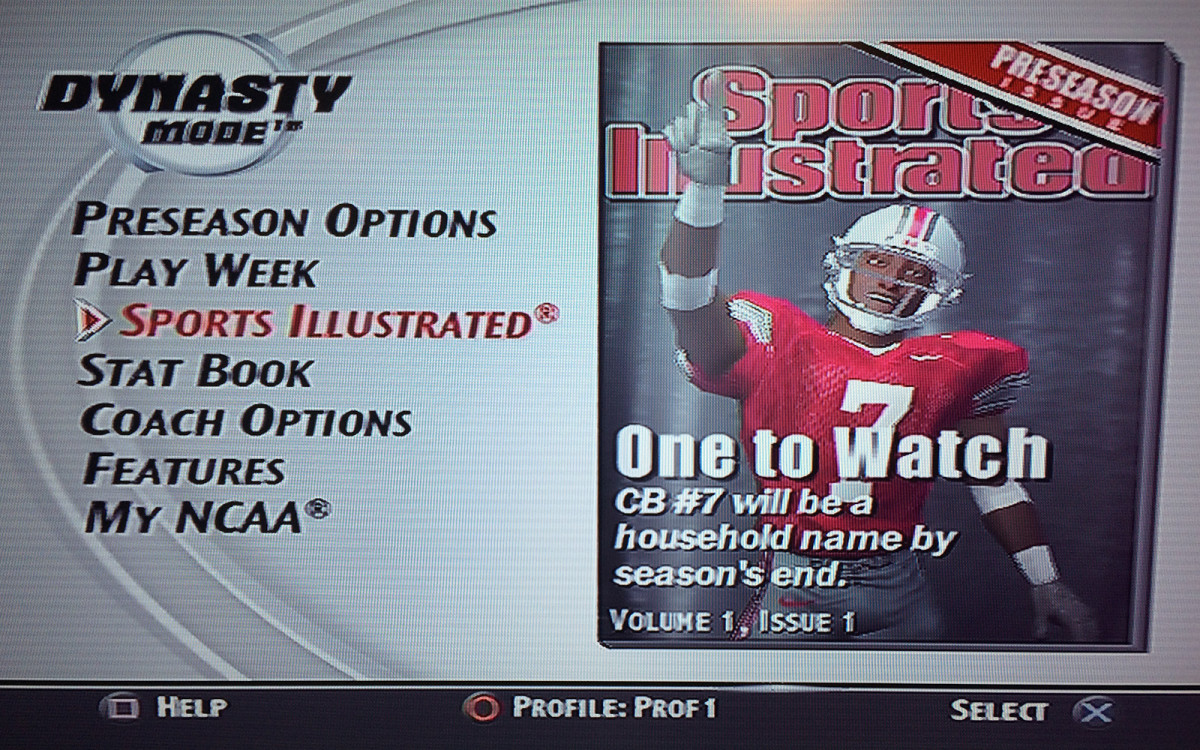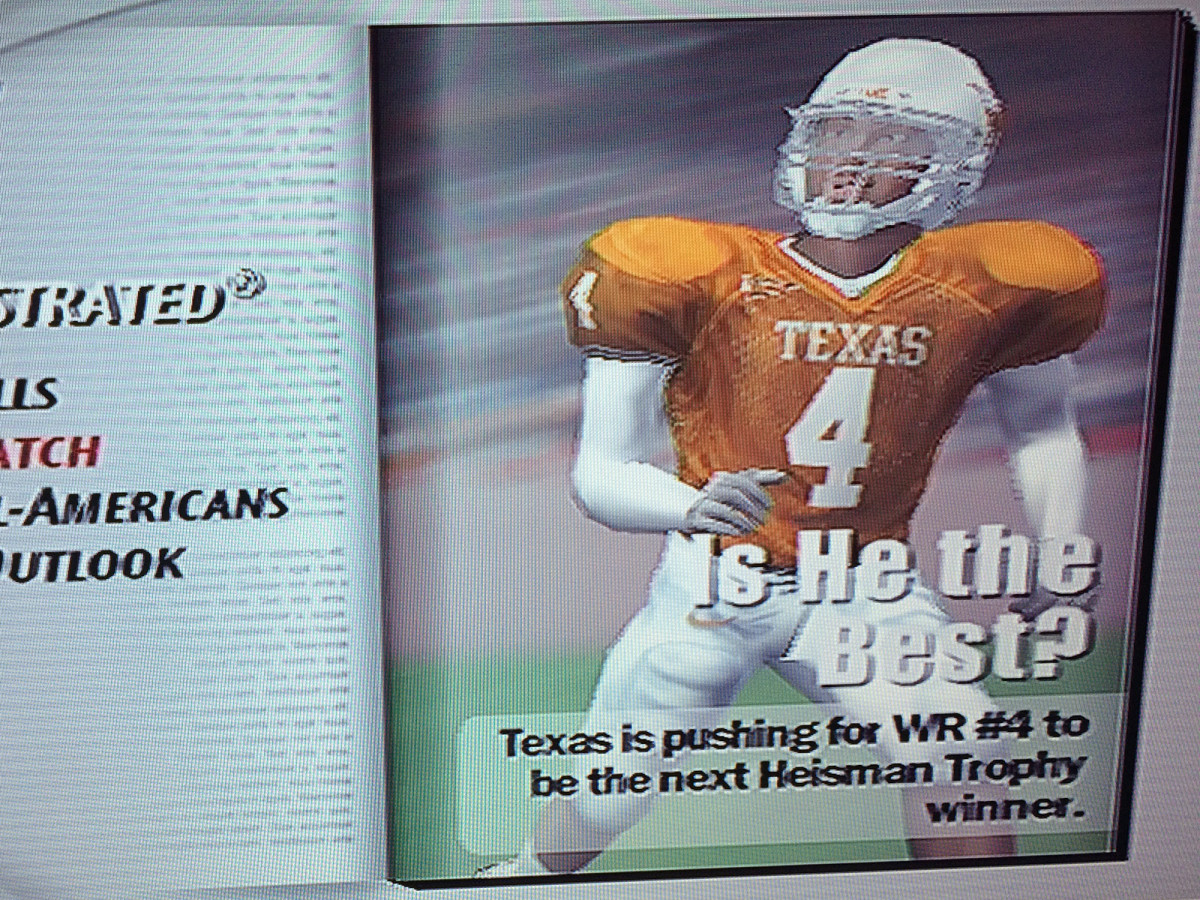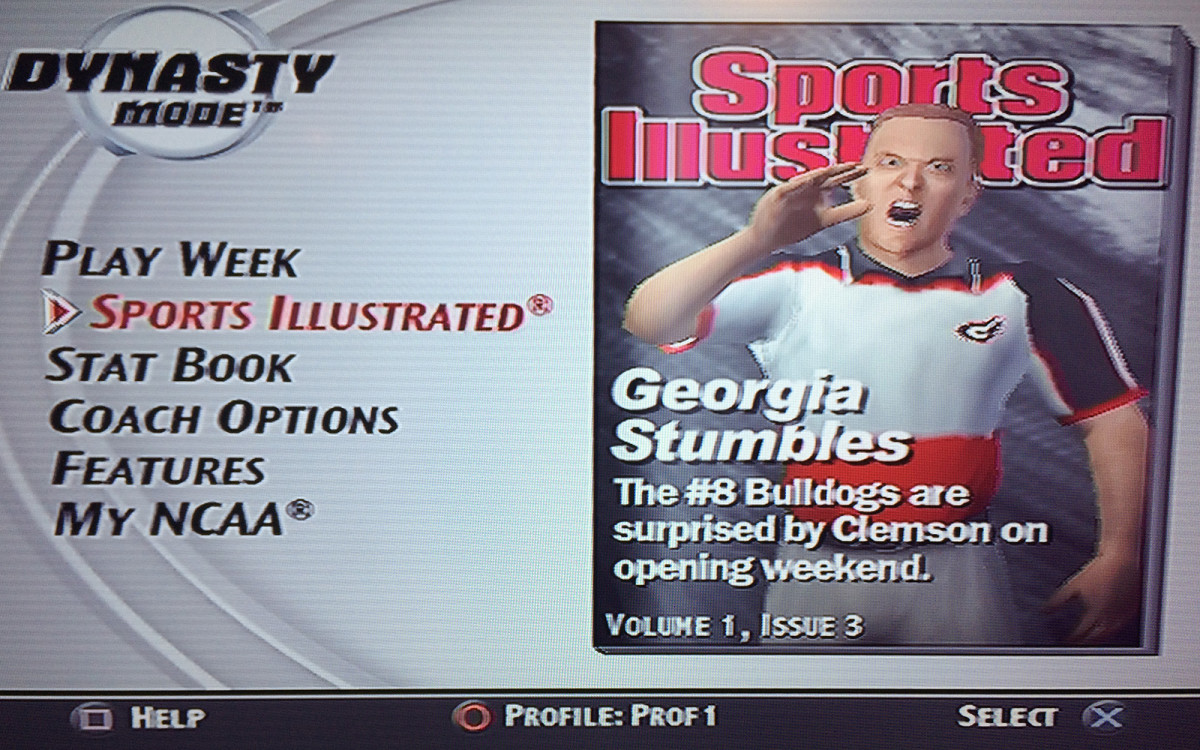How Virtual Sports Illustrated Covers Made It Into EA Sports’s NCAA Football Series

In a three-year span from July 2003 to June 2006, a college football story earned the cover of 16 different issues of Sports Illustrated, but for fans of EA Sports’s NCAA Football video game franchise during that timeframe, the sport got the full SI treatment every single week.
Starting with NCAA Football 2004 (released in July 2003), the popular multi-season gameplay setting Dynasty Mode used a virtual issue of SI as the connective storytelling vehicle for each season, complete with custom headlines and captions on every screen that brought to life games simulated just moments before.
“During the fall, everyone would wait and see who got on the cover of Sports Illustrated in real life—with all the big stories that were going on that week, what would grace the cover?” says Ben Haumiller, a producer at EA who worked on NCAA at the time. “And so you translate that into our world: If Sports Illustrated was just focused on college football, what would be the weekly top story that would grace that cover?”
Made possible by an EA/SI partnership through which new subscribers could get the game two weeks before it hit stores, the inclusion of SI was not billed as a marquee addition to NCAA 2004 nor flagged to reviewers as a game-changing improvement, but in time it became a cherished feature among diehards. Five years since the last NCAA game was released, those artificial SI covers remain beloved inside and outside the building where they were built.
“We thought about how you really represent what’s going on in college football, and we talked about scorecards back then, even websites a little bit,” says Felix Rivero, the EA engineer who brought the feature to life. “But nothing really spoke to the glamour as much as being on the cover of Sports Illustrated at the time.”

The EA Sports employees who made the NCAA Football franchise an iconic part of the video game landscape at the turn of the millennium are just like their creation’s biggest fans in three key ways.
1) They dream of a day when active college athletes are legally able to be compensated for the use of their name, image and likeness, which would pave the way for the return of college football video games that strive to be as realistic as possible, as the NCAA games did before they were discontinued following the release of NCAA Football 14 in July 2013.
2) They still go on nostalgia kicks and pop old games into consoles from the early 2000s to transport themselves back to a time when Nick Saban had one measly national title and USC, Miami and Texas were college football’s gold standard.
3) They believed that much of the fun of playing NCAA was the program-building potential of Dynasty Mode, in which you could, through a combination of shrewd recruiting, player development and patience, develop Northern Illinois into a BCS X-factor, or drop Hofstra University into the old Big East and steal Orange Bowl bids from the Hurricanes and Virginia Tech. (Those two accomplishments took up the majority of the author’s own extensive gameplay experience.)
When Rivero was assigned to be the primary engineer on Dynasty Mode during the production of NCAA Football 2004, lead engineer Jeremy Paulding pulled him aside to drive home just how important Rivero’s new responsibility was. “You need to play it, you need to breathe it, you need to live it,” Rivero recalls Paulding telling him. “‘Dynasty is the bread and butter of NCAA Football. This is why fans love this game so much, because of all the care and all the depth and all the bells and whistles. This is a big deal. I’m not gonna pass this on to anybody, and you need to own this and drive it and make Dynasty great. Are you willing to do that?’ I was like, ‘Woooow. Yes, yes!’”

Many of the details within the Sports Illustrated feature—standings pages, rankings, the Heisman leaderboard—had been available in past editions of NCAA Football, but there was no central hub where a player could see the context of every big game he’d missed while he was absorbed in his own team’s matchup. Complicating matters further, there was no existing program that could pass as a sports desk editor, determining which stories out of a week’s 50-plus games mattered most to the reader and pairing them with a realistic headline, caption and photo. “Our producers at the time, Jeff Luhr and Tom Vuong, pitched the idea to me, and I was kind of terrified at first, honestly, because from a technology standpoint I was like, ‘Oh my gosh, this is gonna be a lot of work,’” Rivero said. “But I really believed in their vision.”
Rivero turned that vision into a story engine, with point values assigned to the details of every single game on the schedule: Heisman-worthy performances, losses that put coaches on the hot seat, Top 25 upsets and anything else the engineers could think of. From there, he simulated a season’s worth of games, collected the 10 best storylines for each team each week, and passed along an Excel document with all that data to Vuong, who combed through the storylines and fine-tuned the points system so that the most important stories would never be passed over.
Then there was the issue of expanding the universe of stories as much as possible, and writing enough headlines and captions so that Sports Illustrated’s virtual editors would not come off as verbally limited robots.

“The whole headline and caption system was kind of like the old Mad Libs,” Rivero said. “You’d plug your team name in, plug in your Heisman candidate, plug in your coach name, and you’d form a sentence. And the important thing to remember is we didn’t just set up stories for just your team because you could change teams at any point within the Dynasty or add users and their teams, and they want a full set of stories too. So we processed every team every single week as well.”
In all, the feature housed 618 unique stories, each of which had anywhere from three to 10 headline-caption combinations that could be used.
The engineers had not yet figured out how to insert still-frame pictures into the feature, so each “SI cover photo” was actually a one-frame animation, frozen and made to look like an action shot. (Rivero says that due to the limitations of the tech back then, the animation didn’t always freeze, leading to the rare edition of SI where players and mascots moved on the cover: “We didn’t have YouTube and everything back then, so people would just think it was a myth and a rumor. ... Bigfoot is real in this case.”)
Bugs aside, the narrative structure of the system worked so well that its key principles remain the standard at EA: As a producer for Madden’s Franchise Mode, the NFL’s answer to Dynasty Mode, Haumiller continues to use the fundamentals of the story engine introduced for NCAA 2004.
“The [SI cover] logic was kind of a pyramid in a way,” Haumiller says. “The most unique storyline had all these different flags, and it was going through and checking: Is this my most unique possible story? And it would go through and if it didn’t trigger one of those flags, it would move down to the next one. At the very bottom case, if it didn’t have anything special to it whatsoever, it was just a big win for the home team, you might get something as simplistic as GREAT WIN FOR THE HOME TEAM as your headline.”

Of course, the real magic of the feature shone through when an SI cover pushed the boundaries of realism: Louisiana-Monroe celebrating a national championship, a San Jose State receiver leading the Heisman polls, No. 1 falling to the worst team in its conference. For some players, including Rivero, the fight for recognition in the virtual pages of SI was a mini-game unto itself that was just as rewarding as the drive for conference and national championships.
“I would love to play a dynasty and take like the lowest-ranked team—we’re talking like ranked bottom of the barrel, No. 123 or whatever the worst was—and you play with them and you get some recruits, and suddenly you win a Top 25 game and you get this cover that’s like: WHO ARE THESE GUYS?” Rivero recalls. “And it’s one of your athletes or your coach on there, and the captions and headlines would all be shocked and surprised, like, ‘Are these guys coming out of whatever city and making a name for themselves?’ And you’d be like, Yes, I’m on my way!”
“Back then you didn’t really have a lot of those touchstone moments,” Haumiller says. “That was one of the first times it really felt like the game is processing what’s happening on the whole in a different way than it ever has before, and it’s presenting these things in a way that’s much more entertaining than just going to a looped screen and saying, ‘Oh, these are the top five Heisman vote-getters.’”
Ahead of the production of NCAA Football 07, EA entered into a partnership with ESPN, at which point the SI covers gave way to ESPN the Mag headlines, but those first three years hold a special novelty to gamers who remember them.
“This feature really still holds up in a way I think we’re still missing in a lot of sports games right now,” Haumiller says. “Just that one hub you felt like it was seamlessly integrated into the UI that you didn’t have to go out of your way to get to it. And it kind of really helped tell a quick story of what was happening in your league and let you get back to whatever else it was you were doing.”
